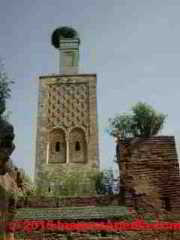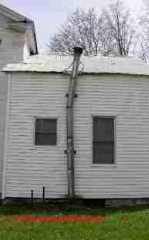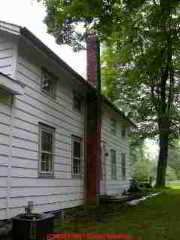 Outdoor Chimney Inspection, from the Ground
Outdoor Chimney Inspection, from the Ground
Ground-level detection of
Leaning Moving or Separating Chimneys
on buildings
- POST a QUESTION or COMMENT about how to inspect chimneys from outdoors at ground level
Chimney inspection points & procedures from outdoors:
This article describes chimney inspection procedures and critical chimney defects which can be observed from outdoors at ground level. We begin with the detection of chimney movement, its causes, its symptoms.
These articles continue with other chimney defects that can be found by visual inspection from outdoors at ground level, then from an on-roof inspection, followed by indoor inspections and ending with chimney-flue interior inspections.
InspectAPedia tolerates no conflicts of interest. We have no relationship with advertisers, products, or services discussed at this website.
- Daniel Friedman, Publisher/Editor/Author - See WHO ARE WE?
Chimney Inspection Procedures - Starting Outdoors
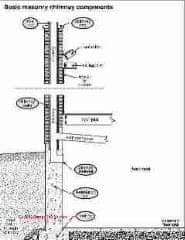
Here is a list of some (not all) common chimney defects visible from a more distant view, perhaps at ground level. Later we detail chimney defects that can best be observed from roof-level access.
[Click to enlarge any image]
- Chimney movement: leaning, settling, bending, breaking, cracks, curving separation from the building, bad footing;
- Chimney height: too short, inadequate clearance above roof; Chimney height too tall without bracing;
see REQUIRED CHIMNEY HEIGHT - Chimney exterior cracked, spalled, loose masonry components (bricks, blocks) or loose, missing mortar
- Chimney leaks: water leaking into the chimney interior or structure, such as efflorescence, frost cracking, spalling
- Chimney cap missing, chimney cap not draining; wrong type of cap for flue type or items being vented
- Chimney crown cracked, damaged, missing, leaking, or not properly sloped to drain off of the chimney top; no drip edge over chimney sides. Some experts including Al Carson call our "crown" the chimney cap. Sketch above showing the basic parts of a masonry chimney is courtesy of Carson Dunlop.
- Chimney type & usage: chimneys improperly shared among appliances, building rooms or building floors, or chimneys of the wrong type in use.
We describe these and other chimney defects in detail in the following sections of this article.
Chimney Separation from House, Settlement, Leaning, Movement, Cracking
A chimney which has settled and moved away from the building is almost certainly a serious safety hazard risking fire and flue gas leaks into the structure, and it is likely to require costly repairs or complete reconstruction. Details of how to see and evaluate chimney movement and separation are provided here.
Foundation Support for Masonry Chimneys
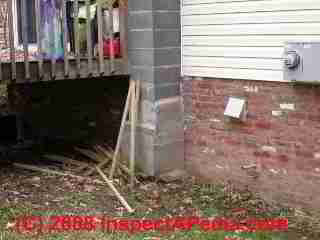 A summary of the chimney footing problem is just below.
A summary of the chimney footing problem is just below.
What happens if a chimney footing is missing or inadequate? Masonry chimneys represent a heavy concentrated load on the soil or support structure.
Therefore, proper footing support is critical and is generally separated from the building footings except possibly at the exterior wall.
Some masonry chimneys are constructed with an inadequate footing, or no supporting footing whatsoever.
A common mistake is to build a chimney whose footing sits atop un-compacted back-fill that was pushed against the building's basement and foundation walls.
Future settlement, movement, tipping, or separation of the chimney from the building is certainly likely in such installations.
Even a casual inspection from outside would raise the question about the absence of a footing for the chimney shown in our photo. You will notice the erosion of soil from below a little concrete skirt around the chimney base of this concrete block chimney.Homes built upon dry-laid stone foundations may have a chimney installed with its base sitting atop the foundation wall itself. Those chimneys might be stable, but be sure to review our warnings
about DEAD END FLUES that are usually in use where such chimneys were built with no extension very far below ground level.
We provide a series of articles on diagnosing chimney cracks and movement beginning
at CHIMNEY MOVEMENT CAUSES,
then CHIMNEY MOVEMENT, ONGOING vs STATIC where we describe determining whether chimney movement is ongoing.
We continue below with an explanation of the causes of chimney movement, followed by a demonstration of how we spot evidence that chimney movement has been ongoing. Other articles in this series outline most other chimney defects that can be found outdoors or indoors on buildings.
Other Chimney Defects Visible by Outdoor Ground-Level Inspection
Overgrown chimneys & flues - trim back vegetation
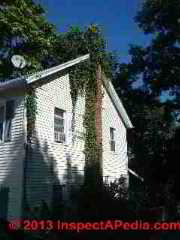
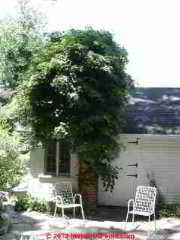
Watch out: As you can certainly see from our photos above, tree, shrubbery or vine growth close to or covering a chimney can be a serious or even fatal hazard including risk of
- Fatal carbon monoxide poisoning of the building occupants - venting a gas appliance into a chimney that is blocked by over-growth or blocked by anything else is likely to both cause production of high levels of carbon monoxide (especially from gas fired heating equipment) and to cause the fatal venting of carbon monoxide back into the building.
- House fire - when chimney sparks ignite dried vegetation
- Chimney structural damage as vine growth holds moisture on or in the chimney surfaces
- Also see BLOCKED CHIMNEY FLUES
- CARBON MONOXIDE - CO
See VINES & SHRUBS on BUILDING WALLS, CHIMNEYS for advice on removing vines from building walls and chimneys.
Bird or other animal nests in or on chimneys - fire & gas hazards from blocked chimneys
As you can certainly see from our photo (left), this chimney, located in Rabat, Morocco, serves as a home for a stork's nest. This chimney top is essentially totally blocked by highly-combustible material - a bird's nest.
Watch out: even in areas where storks are not common, other smaller birds, squirrels, and some other animals may make a smaller nest inside the chimney or its flue, presenting hazards of blocked flue, fire, and potentially fatal carbon monoxide poisoning.
Risk of Hidden Chimney Damage - hybrid structures
This next chimney shown at below left ... well we're not sure what the heck we've got here.
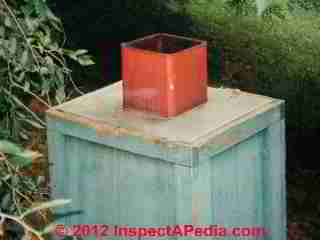 We see a fired clay masonry flue tile projecting through a flat, leaky, too small, metal chimney cap surrounded by a wood and plywood structure.
We see a fired clay masonry flue tile projecting through a flat, leaky, too small, metal chimney cap surrounded by a wood and plywood structure.
We suspected that this was a masonry chimney that had suffered frost damage.
The owner installed a new clay flue tile at the very chimney top and boxed in the masonry chimney to cover the frost-damaged chimney structure (the home was being sold).
We've got a few concerns:
- a missing rain cap - risking hidden damage to flue, flue vent connectors, heating equipment below
- a defective leaky chimney cap or crown risking hidden damage to the chimney itself
- wood framed covering over a chimney of uncertain material and condition, possibly adding to the fire hazard
- a risk of hidden damage, unsafe flue, fire hazards, flue gas leak hazards
See CHIMNEY CAP & CROWN DEFINITIONS for definitions of chimney rain cap, chimney cap, chimney crown, and for more examples of chimney top defects that may be visible from the ground or from an on-roof inspection.
Poorly-secured or poorly-supported factory-built chimneys risk collapse
As you can certainly see from our photo (left), this chimney is collapsing and is unsafe. More about this chimney is found
at BRACING for METAL CHIMNEYS.
...
Reader Comments, Questions & Answers About The Article Above
Below you will find questions and answers previously posted on this page at its page bottom reader comment box.
Reader Q&A - also see RECOMMENDED ARTICLES & FAQs
On 2021-02-04 - by (mod) -
Sorry the last word of my comment got chopped off it was
make sure that your chimney is safe
On 2021-02-04 - by (mod) -
LeAnn
Typically of bricks or concrete blocks near the base of a chimney are spoiling or deteriorating it's because they're being exposed to excessive amounts of water, perhaps from rain splash pad off of a roof Edge because of poorly maintained gutters and downspouts.
Keep water away from the chimney base and you'll also reduce the chances that it's leaking into the chimney or even into the building where it will cause further damage.
If there's signs of movement in your chimney or if the spelling is more than superficial then you should have your chimney inspected by a certified chimney sweep or an experienced Mason to be sure that the chimney is
On 2020-10-17 by leann
purchased home 2 yrs ago and with this covid thing had a lot of time on my hands. So I started looking at my house which was pretty sad. I thought this house was sound and in really good shape. The main issue I just noticed was the bottom of the chimneys bricks and mortar were cracking and it looked like mice were digging underneath. Park construction brought the mice here.
Not knowing if this is a footing problem or foundation issue or none of the above we just packed dirt in around the foundation and put 2x8 brick slabs and large flat rocks on top to keep the rodents out. What do you think is causing the masonry work on the bottom to crumble of break away? any idea? thank you
On 2018-12-09 by (mod)
Thank you for helpful question.
You need to be sure that the ground slopes away from the building for no less than 10 feet and you want to be sure that the roof drainage system is working, that is that it is not spilling water close to the foundation
On 2018-12-04 by steve farias
have a fireplace in my home on a exterior wall. brick is all the way to ground level .with footing underneath. what should i do to keep ground
away from bricks and water
On 2016-07-20 - by (mod) -
Arthur please see TERMITE DAMAGE INSPECTION at https://inspectapedia.com/structure/Termite_Inspection.php
On 2016-07-20 - by Arthur
RE-posting from unknown original page:
COMMENT:What are best practices to remove an invasive climbing vine and repair an exterior residential wall (condo building). THe exterior wall is painted white and is composed of a thin stucco like layer , over cement layer over soft red brick wall. The condo building is a cement iron rebar reinforced columns and floors with the walls filled in by brick.
There is no insulation externally or on the interior. There is no or vapor barrier or moisture wrapping or wood material. Environmentally, the condo is in a very humid tropical weather like zone with a heavy rainey season during the summer (Now through OCTOBER) and dry season during winter through spring.
The climbing vine (locally called moneda d' oro- unsure of spelling) roots have infiltrated ,through the cement and red brick to the interior wall on some condos. Water infiltration is a problem on the interior of some condo apartments and deterioration of the wall is evident. Previous attempts from property management only resulted in infrequent pulling off the vines of the wall up to 4 stories.
The vines grow back and the damage to the wall is never repaired. Now there is water infiltration and roots that have penetrated the stucco like thin covering over soft red brick. It rains every day now as we are in the rainey season and one condo owner wants to pursue removing the vines and repairing the exterior wall now.
The contractor proposes pulling off the vines and wash wall down with muriatic acid then repairs brick mortar where necessary and apply cement coating and then a thin layer of stucco-like coating and paint white.
Considering the use of muriatic acid, and pulling off the growth, my concern is there are roots within the walls (bricks) where pulling out the vines may cause more unecessary damage as oppose to burning with a torch.
Or, will muriatic acid be sufficient to remove the thin woody roots embedded in walls? Did I mention that we have a terranean termite issue although not seen on this wall visually. Any advice to properly remediate this situation for good with a proactive maintenance plan will be appreciated at your earliest convenience. and with this being rainey season raining everyday is this the t...
Question:
(Oct 23, 2011) Cracks in a Masonry Chimneys said:
If my fireplace has been converted to a gas insert...with the flue and everything replaced, is it safe to just repair the cracks in the exterior of the chimney?...and paint it?
Reply:
You should have the flue safety inspected by a professional chimney sweep.
Question:
(Jan 6, 2013) pam said:
there was a leak from chimney during heavy rain although no loss of any tiles. What could be the cause of the leak?
Reply:
Flashing errors at the chimney or a bad or missing chimney cap or damaged chimney to crown.
...
Continue reading at CHIMNEY LEANING, SEPARATION, MOVEMENT or select a topic from the closely-related articles below, or see the complete ARTICLE INDEX.
Or see these
Recommended Articles
- CHIMNEY INSPECTION at ROOFTOP that describes chimney defects which may be difficult or impossible to detect from a ground-level inspection,
- MASONRY CHIMNEY GUIDE - home
- CHIMNEY INSPECTION DIAGNOSIS REPAIR - home
- CHIMNEY STAINS & LEAKS
- SOIL PROPERTIES & BUILDING FAILURES - building a chimney footing on fill invites chimney damage and hazards
- VINES & SHRUBS on BUILDING WALLS, CHIMNEYS
Suggested citation for this web page
CHIMNEY INSPECTION from GROUND at InspectApedia.com - online encyclopedia of building & environmental inspection, testing, diagnosis, repair, & problem prevention advice.
Or see this
INDEX to RELATED ARTICLES: ARTICLE INDEX to CHIMNEYS & FLUES
Or use the SEARCH BOX found below to Ask a Question or Search InspectApedia
Ask a Question or Search InspectApedia
Try the search box just below, or if you prefer, post a question or comment in the Comments box below and we will respond promptly.
Search the InspectApedia website
Note: appearance of your Comment below may be delayed: if your comment contains an image, photograph, web link, or text that looks to the software as if it might be a web link, your posting will appear after it has been approved by a moderator. Apologies for the delay.
Only one image can be added per comment but you can post as many comments, and therefore images, as you like.
You will not receive a notification when a response to your question has been posted.
Please bookmark this page to make it easy for you to check back for our response.
IF above you see "Comment Form is loading comments..." then COMMENT BOX - countable.ca / bawkbox.com IS NOT WORKING.
In any case you are welcome to send an email directly to us at InspectApedia.com at editor@inspectApedia.com
We'll reply to you directly. Please help us help you by noting, in your email, the URL of the InspectApedia page where you wanted to comment.
Citations & References
In addition to any citations in the article above, a full list is available on request.
- Roger Hankeyis principal of Hankey and Brown home inspectors, Eden Prairie, MN, technical review by Roger Hankey, prior chairman, Standards Committee, American Society of Home Inspectors - ASHI. 952 829-0044 - hankeyandbrown.com
- "Top Ten Chimney (and related) Problems Encountered by One Chimney Sweep," Hudson Valley ASHI education seminar, 3 January 2000, contributed by Bob Hansen, ASHI
- Chimney Inspection Checklist, Carson Dunlop, Associates, Toronto, Ontario
- "Rooftop View Turns to Darkness," Martine Costello, Josh Kovner, New Haven Register, 12 May 1992 p. 11: Catherine Murphy was sunning on a building roof when a chimney collapsed; she fell into and was trapped inside the chimney until rescued by emergency workers.
- "Chimneys and Vents," Mark J. Reinmiller, P.E., ASHI Technical Journal, Vol. 1 No. 2 July 1991 p. 34-38.
- "Chimney Inspection Procedures & Codes," Donald V. Cohen was to be published in the first volume of the 1994 ASHI Technical Journal by D. Friedman, then editor/publisher of that publication. The production of the ASHI Technical Journal and future editions was cancelled by ASHI President Patrick Porzio. Some of the content of Mr. Cohen's original submission has been included in this more complete chimney inspection article: CHIMNEY INSPECTION DIAGNOSIS REPAIR . Copies of earlier editions of the ASHI Technical Journal are available from ASHI, the American Society of Home Inspectors.
- Natural Gas Weekly Update: http://tonto.eia.doe.gov/oog/info/ngw/ngupdate.asp Official Energy Statistics from the U.S. Government
- US Energy Administration: Electrical Energy Costs http://www.eia.doe.gov/fuelelectric.html
- Our recommended books about building & mechanical systems design, inspection, problem diagnosis, and repair, and about indoor environment and IAQ testing, diagnosis, and cleanup are at the InspectAPedia Bookstore. Also see our Book Reviews - InspectAPedia.
- NFPA 211 - 3-1.10 - Relining guide for chimneys
- NFPA 211 - 3-2 - Construction of Masonry Chimneys
- NFPA 211 - 3-3 - Termination Height for chimneys
- NFPA 211 - 3-4 - Clearance from Combustible Material
- NFPA 54 - 7-1 - Venting of Equipment into chimneys
- Brick Institute of America - Flashing Chimneys
Brick Institute of America - Proper Chimney Crowns
Brick Institute of America - Moisture Resistance of Brick - American Gas Association - New Vent Sizing Tables
- Chimney Safety Institute of America - Chimney Fires: Causes, Effects, Evaluation
- National Chimney Sweep Guild - Yellow Pages of Suppliers
- In addition to citations & references found in this article, see the research citations given at the end of the related articles found at our suggested
CONTINUE READING or RECOMMENDED ARTICLES.
- Carson, Dunlop & Associates Ltd., 120 Carlton Street Suite 407, Toronto ON M5A 4K2. Tel: (416) 964-9415 1-800-268-7070 Email: info@carsondunlop.com. Alan Carson is a past president of ASHI, the American Society of Home Inspectors.
Thanks to Alan Carson and Bob Dunlop, for permission for InspectAPedia to use text excerpts from The HOME REFERENCE BOOK - the Encyclopedia of Homes and to use illustrations from The ILLUSTRATED HOME .
Carson Dunlop Associates provides extensive home inspection education and report writing material. In gratitude we provide links to tsome Carson Dunlop Associates products and services.


